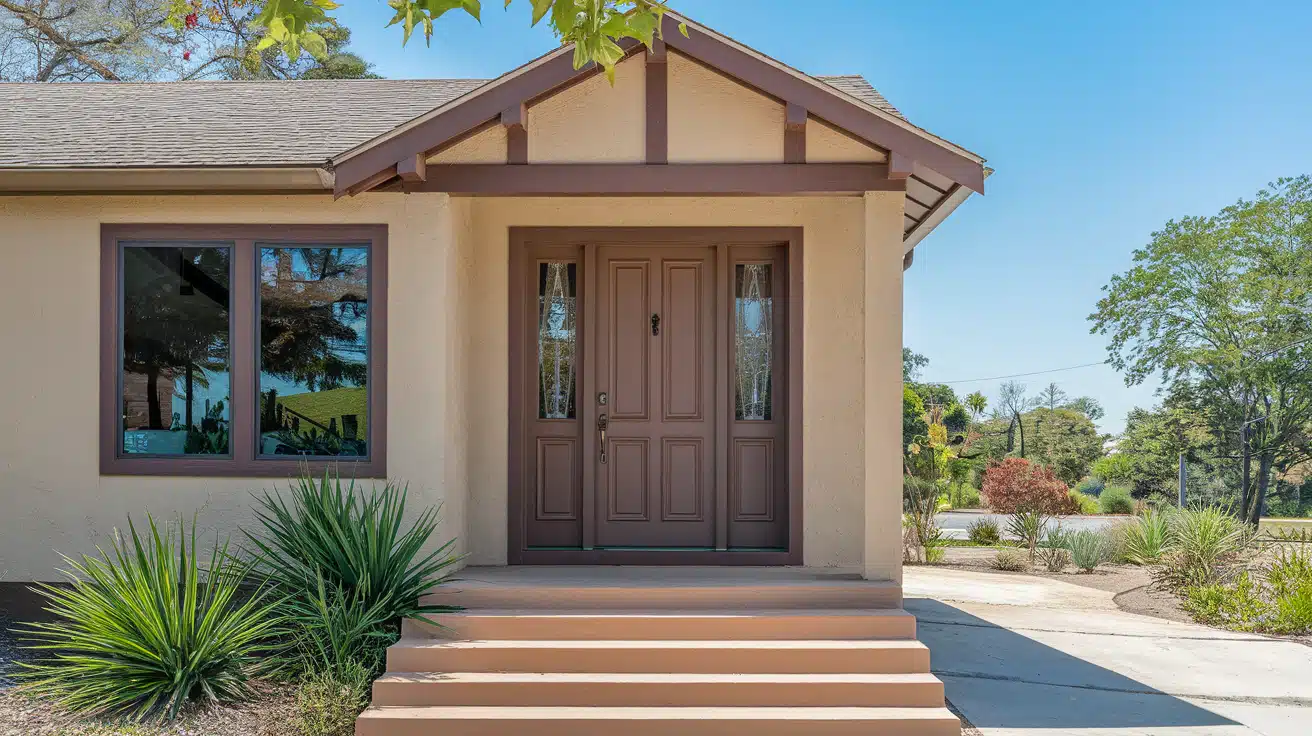Choosing the right colors for your home’s exterior can feel like a puzzle. Many homeowners wonder if their door and trim should match or contrast; unsure which option creates the best look.
I understand this common design dilemma because the right choice can truly enhance a home’s curb appeal.
I’m here to help you solve this color question once and for all. In this guide, I’ll explain the benefits of matching and contrasting your door and trim and share practical tips for making the best choice for your specific home.
You’ll learn about color selection, maintenance factors, and design principles that will help you make a confident decision that boosts your home’s value and reflects your style.
Doors and Trim: To Match or Not to Match?
The answer depends on your goals for your home’s appearance. Matching creates a cohesive, seamless look, while contrasting adds visual interest and highlights architectural features.
Match your door and trim if you prefer modern or minimalist styles, want your home to appear larger, or value simplified maintenance.
Choose contrasting colors if you want to make a bold statement, own a historic home with unique architectural details, or wish to add depth and dimension to your exterior.
Matching vs. Contrasting: Which Color Scheme Works Best?
| Matching | Contrasting |
|---|---|
| Creates a cohesive and polished look | Adds visual interest and contrast |
| Easier maintenance with a single paint color | Can highlight architectural features |
| It can make a small space feel larger | Works well for modern or bold designs |
| Simplifies color decisions | Offers more design flexibility |
| Works best for traditional and classic homes | Suits eclectic or contemporary styles |
Top 6 Matching Door & Trim Color Pairings
1. White Door & White Trim
White is a timeless and clean combination that suits almost any home style. This pairing creates a bright look that shows off your home’s best features. White helps make small spaces look bigger and works well in both sunny and shaded areas.
2. Black Door & Black Trim
A bold yet classy choice that makes a clear statement, black is a great choice for modern homes with simple lines. The dark color brings focus to entry points and window shapes, adding weight and standing out against light-colored walls.
3. Gray Door & Gray Trim
Soft gray creates a peaceful and simple look that fits many home styles. This color choice offers quiet beauty without drawing too much attention. Gray works well with stone, brick, or siding in various colors.
4. Navy Blue Door & Navy Blue Trim
A rich blue for both the door and trim creates a classic look with character. This pairing suits homes near water or with a time-honored design. Navy stays clean-looking longer than lighter colors and hides dirt well.
5. Olive Green Door & Olive Green Trim
Olive green is a nature-inspired choice that adds warmth to your home’s exterior. This pairing fits well with homes among trees or natural settings. Olive green changes subtly with different light, looking fresh all day long.
6. Beige Door & Beige Trim
Beige is a soft, neutral pairing that works well on cottage and old-style homes. It adds warmth while keeping things simple. This color hides dust and dirt better than white but still gives a clean finish.
How It Affects Curb Appeal and Property Value
A home with matching doors and trim often looks more expensive. This clean, high-end appearance can boost your home’s value when it’s time to sell, and many buyers prefer this timeless look.
Bold doors with neutral trim create a memorable first impression, making your home stand out in photos and listing tours. Real estate agents often suggest a fresh coat of paint in this style before putting homes on the market.
Recent housing trends show that both approaches work well, but matching colors tend to appeal to more buyers. Softer, neutral tones typically perform best for maximum sale value.
Psychological and Emotional Influence
Colors affect how we feel about a space. Soft, matching neutrals create a sense of calm and order, while bold, contrasting colors add energy and personality.
In the feng shui tradition, door colors carry meaning. Red doors are thought to welcome good luck and success. Black doors create a sense of safety and protection. Blue doors suggest peace and harmony.
Trim color frames the view both into and out of your home. Light trim can make windows seem larger and draw more attention to the view, while dark trim creates a strong border between inside and outside spaces.
Lighting and Environmental Factors
Colors look different depending on light exposure. South-facing doors get more sun, making colors appear lighter and sometimes more faded over time.
Shaded entrances may need lighter colors to prevent a dark, unwelcoming look. Test your paint samples at different times of day to see how light changes their appearance.
The climate also affects your choice. In hot regions, lighter colors reflect heat and stay cooler. In rainy areas, darker colors can better hide water spots and dirt between cleanings.
Common Mistakes to Avoid in Door and Trim Color
| Mistake | Why It Happens | How to Avoid It |
|---|---|---|
| Ignoring Light Conditions | Store lighting differs from natural light. | Test samples at home in different lighting. |
| Rushing Prep Work | Eager to finish quickly. | Clean, sand, and prime properly for durability. |
| Tiny Color Swatches | Small samples misrepresent large surfaces. | Use larger boards or test patches. |
| Using Cheap Paint | Saving money upfront. | Invest in high-quality exterior paint. |
| Ignoring Home Style | Following trends without context. | Choose colors that fit your home’s architecture. |
| Forgetting the Weather | Painting in poor conditions. | Paint on dry, mild days (50-85°F). |
Conclusion
Your door and trim colors make a big impact on your home’s overall look. Whether you choose matching colors for a seamless appearance or contrasting hues for visual interest, the right choice depends on your home’s architecture, style, and practical considerations.
Remember to test sample colors in different lighting conditions before making your final decision. Take time with preparation and use quality materials for best results.
Most importantly, pick colors that make you happy when you pull into your driveway. Your home should reflect your personality while complementing its architecture.
Need help deciding? Consider consulting with a professional painter who can suggest color options that complement your home’s specific features and neighborhood setting.















